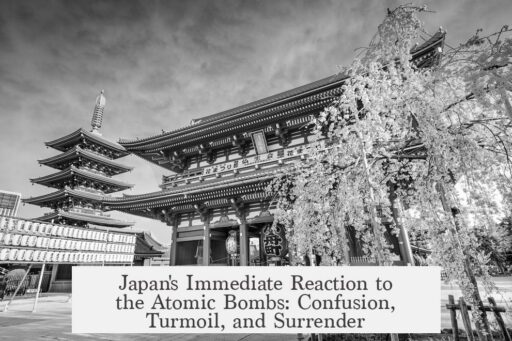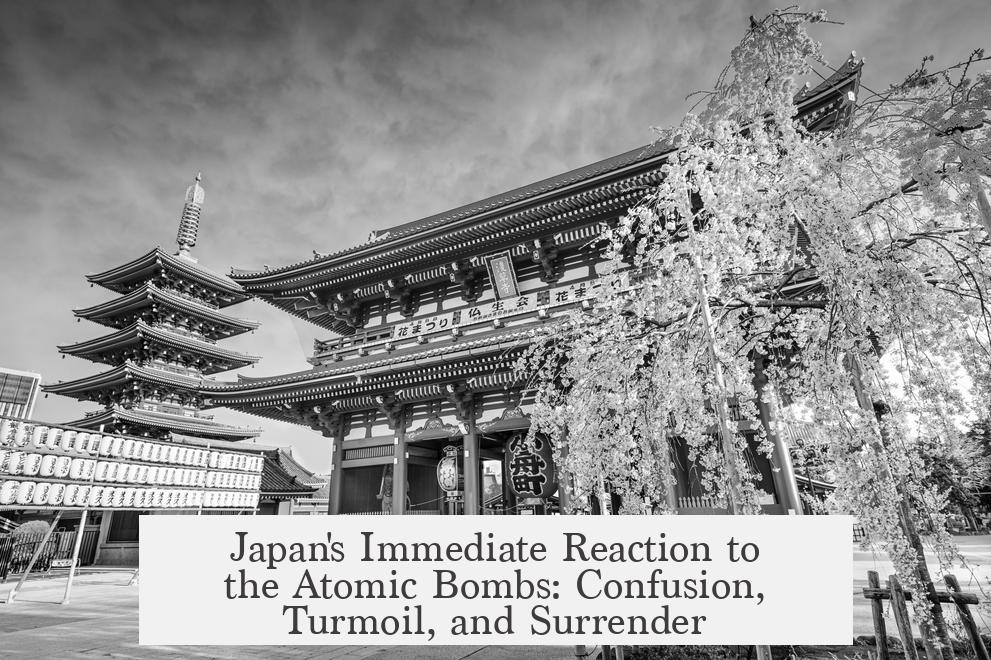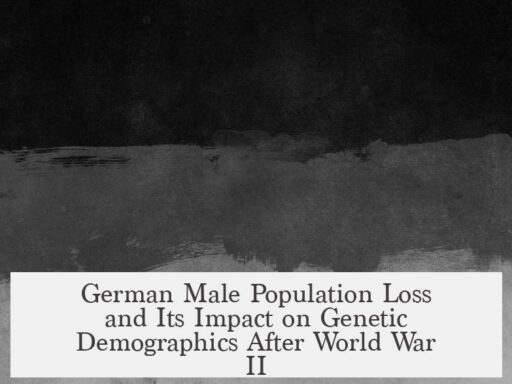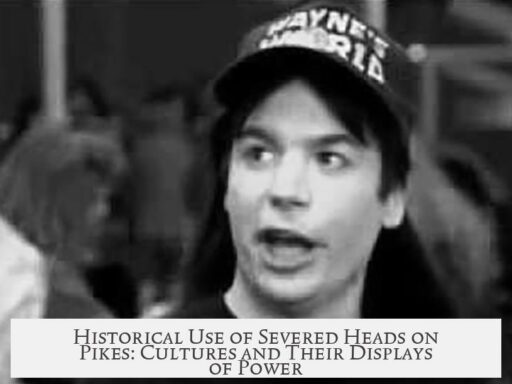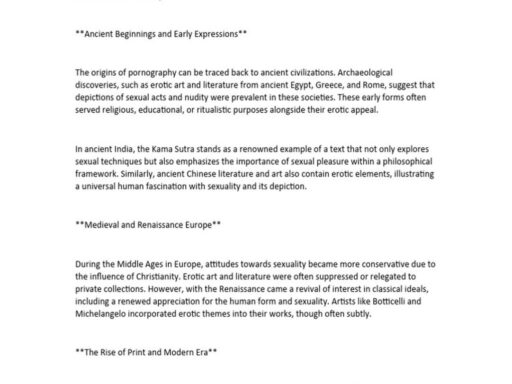Japan’s immediate reaction to the atomic bombs was a mix of initial confusion, propaganda-driven interpretation, rising awareness of devastation, domestic unrest, and eventual acceptance of surrender. The Japanese government and people first learned about the bombing of Hiroshima on August 6, 1945, mainly through sparse and vague media reports. Over the next days, their understanding and response evolved rapidly, influenced by official announcements, propaganda narratives, and the subsequent Nagasaki bombing.
At first, Japanese media and authorities relayed limited, cautious information. On August 6, Radio Domei briefly mentioned President Truman’s announcement of the atomic bombing without specifying its impact. Osaka radio noted disruptions in train schedules near Hiroshima but offered no cause. Other broadcasters described the event simply as a bombing raid by a small number of B-29 bombers using explosives and incendiaries, avoiding any explicit reference to the atomic nature of the bomb.
Early media reports on August 8 framed the bomb as a “new-type bomb” and deferred detailed descriptions of damage. Domei radio presented the bombing as an act of American impatience with the slow pace of invading Japan’s mainland. Broadcasts condemned the attack as an inhuman, barbaric tactic, branding the United States as a destroyer of justice and mankind. The weapon was described as detonating in mid-air with a parachute attached, downplaying its destructive power while admitting it was significant. Japanese authorities asserted they were working on countermeasures, trying to maintain morale despite acknowledging the threat.
Awareness of the bomb’s catastrophic effects sharply increased by August 9. Tokyo Radio reported massive casualties and destruction in Hiroshima, noting the death toll was “too many to count” and virtually all living beings in the city were destroyed by the blast. Japanese propaganda accused the US of violating the Hague Convention and contrasted the atomic bombings with Japan’s own aerial attacks on Chinese cities, portraying those as more “humane” to bolster moral outrage.
The bombing of Nagasaki on August 9 was not initially reported by Japanese radio, illustrating censorship or denial. Instead, broadcasts from Japanese sources in Singapore claimed possession of a similar weapon and accused the Allies of stealing their scientific research. These statements were clearly propaganda intended to project strength despite the dire situation.
By August 11, Domei agency announced Japan’s formal protest to the US against the atomic bomb’s use. Inside Japan, media noted growing domestic unrest. Newspapers criticized government handling of the war. Rumors of riots circulated in Tokyo, signaling eroding public confidence and social tension. On August 12 and 13, Tokyo newspapers urged national unity and obedience. They claimed preparedness for any further atomic attacks. Domei radio downplayed the bomb’s power in foreign broadcasts, trying to minimize the perceived threat internationally.
The Imperial War Council wrestled with the bomb’s implications. Japanese scientists understood atomic weapons theoretically but believed Japan lacked the industrial capacity to produce them. After Hiroshima, scientists surmised the weapon was atomic and that the US had only one or two such bombs. The Nagasaki bombing shattered this belief, signaling the US might possess multiple atomic weapons, greatly intensifying Tokyo’s alarm.
On August 14, Emperor Hirohito announced Japan’s surrender. His speech referenced the “new and most cruel bomb” causing incalculable damage and warned that continuing the war risked total collapse and extinction of the Japanese nation, as well as human civilization. He emphasized the need to save millions of subjects and atone before imperial ancestors, framing surrender as a grave but necessary decision to avoid further destruction.
- Initial reports of the atomic bomb were vague and incomplete, with Japanese media using cautious language and propaganda to frame the event.
- By August 9, the full scale of Hiroshima’s devastation became clear, leading to public shock and condemnation of the US.
- Domestic unrest emerged, with criticism of the government and rumors of riots reflecting growing distress within Japan.
- Japanese scientists gradually concluded the bomb was atomic but limited, until Nagasaki showed US production was large-scale.
- On August 14, Emperor Hirohito publicly surrendered, acknowledging the atomic bomb’s destructive power and the necessity to end the war.
What Was Japan’s Immediate Reaction to the Atomic Bombs? A Deep Dive into the Shock, Denial, and Surrender

Japan’s immediate reaction to the atomic bombs was a complex mixture of shock, propaganda-driven denial, and gradual grim acceptance that ultimately led to surrender. But this response wasn’t a straightforward shock-and-awe scenario. Instead, it unfolded over several days, evolving in the face of horrifying new realities. Let’s unravel what exactly went through Japanese minds and media right after Hiroshima and Nagasaki were devastated.
Picture the tension: August 1945, the world at war, and suddenly—an entirely new, terrifying weapon changes everything.
Early Days: Confusion & Cautious Reporting
When the first atomic bomb fell on Hiroshima on August 6, 1945, immediate Japanese reports were vague and circumstantial. Radio Domei, Japan’s wartime news agency, announced President Truman’s claim of a new “atomic bomb” but carefully avoided describing the grotesque effects. The announcement was more like a cryptic news ticker than a blunt reality-check.
Osaka radio chimed in but only reported that train schedules to Hiroshima prefecture were disrupted—no mention of why. Other broadcasters called it a raid by a small wave of B-29 bombers dropping incendiaries and explosives. The atomic nature of the bomb wasn’t openly acknowledged. Why? Perhaps fear, perhaps wartime censorship, or strategic denial.
By August 8, newspapers began labeling the weapon a “new-type bomb,” again skirting around the actual destruction. Domei radio suggested the Americans resorted to this “inhuman” tactic out of impatience, essentially punishing Japan because the invasion wasn’t proceeding fast enough. Talk about putting a twisted spin on madness!
“The resort to such inhuman tactics is sufficient to brand the enemy for ages as destroyers of justice and mankind.”
This early propaganda vigorously condemned the U.S. as sadistic, accusing them of wanting to massacre innocent civilians. Yet, reporters hinted that Japanese authorities were secretly devising countermeasures—probably hoping to reassure the public that not all was lost.
The Grim Reality Sinks In: August 9-10
By August 9, Tokyo Radio’s tone darkened significantly. Reports described the massive casualties in Hiroshima, saying the dead were “too many to count.” It painted a harrowing image: “virtually every living thing” in the city was incinerated by the blast. These were not just words—this was the dawning realization that the new weapon’s destructive power was unlike anything seen before.
Meanwhile, the U.S dropped a second bomb on Nagasaki on August 9, but Japanese radio initially stayed silent about it. When they did mention comparable weapons, Japanese broadcasters in Singapore made bold, if entirely false, claims that Japan had its own atomic bomb in the works—and accused the Allies of stealing Japanese research. This was pure wartime propaganda, trying to maintain morale through fiction.
Interestingly, Japanese media accused the U.S. of violating the Hague Convention in these bombings, though technically Japan wasn’t a signatory to that treaty—an ironic twist in the propaganda narrative. The bombings were framed as barbaric, a desperate act by a faltering enemy forced to resort to new horrors.
Domestic Turmoil and Rising Unrest
By August 11, things inside Japan were tense. The Domei agency reported Japan had formally protested to the U.S. government over the use of these “inhuman” bombs. At the same time, signs of domestic unrest began surfacing. Newspapers openly criticized the government’s failure to effectively defend the homeland. Rumors of riots simmered in Tokyo—proof that the atomic bombings had not only physical but psychological shockwaves.
On August 12 and 13, Tokyo newspapers called for unity and obedience, promising the public that preparations were underway for future attacks. Domei radio downplayed the bomb’s power abroad, perhaps attempting to calm nerves and control the narrative.
The Imperial War Council and Scientific Assessment
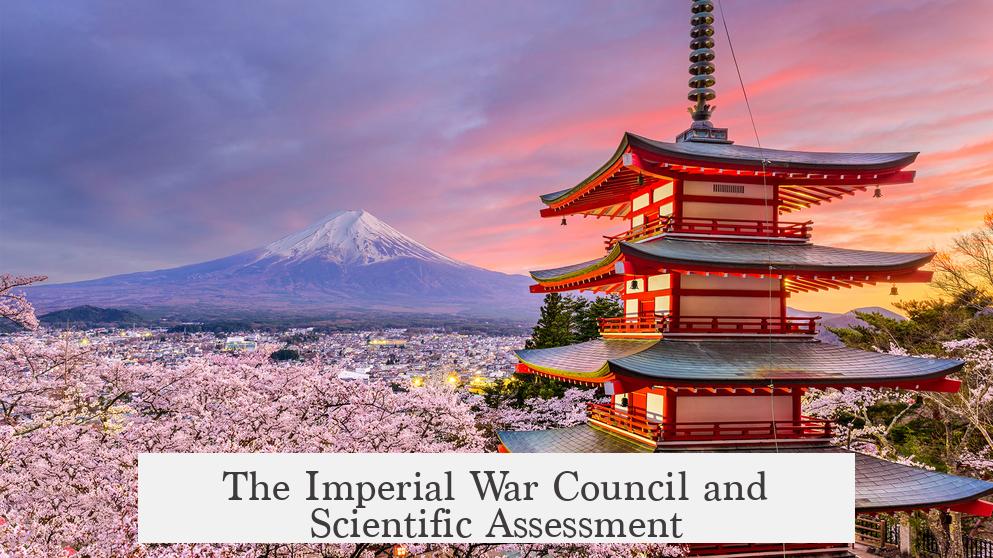
Behind the scenes, Japan’s scientific elite had a clearer understanding. They already knew about atomic weapons through scientific channels but assumed Japan lacked the industrial might to produce them. After Hiroshima, scientists deduced the bomb was almost certainly atomic but believed it was a one-shot weapon. This was not just wishful thinking—it was based on their surveillance that detected no massive bombing raids following Hiroshima.
The Nagasaki bombing, however, shattered this hope. A second bomb, dropped so soon after the first, told Japanese leaders one thing clearly: the U.S. could produce multiple atomic bombs. The implications were chilling. There wasn’t just one new weapon; there could be many. This development profoundly escalated the crisis within the Imperial War Council.
Emperor Hirohito’s Historic Surrender Message
Then came the climax. On August 15, Emperor Hirohito broke a precedent—he personally addressed the nation. His speech mentioned the “new and most cruel bomb,” emphasizing its immeasurable destructive power and the awful toll it had taken on innocent lives. He warned the continuation of the war would lead not just to Japan’s destruction but potentially to the extinction of human civilization itself.
“Should we continue to fight, it would… lead to the total extinction of human civilization.”
This wasn’t just surrender; it was a plea for the survival of the entire species. Hirohito cited the need to save millions of Japanese lives and to “atone before the hallowed spirits of our imperial ancestors” as key reasons to accept the Allied terms. The imperial authority, long seen as divinely inspired and unshakeable, now openly acknowledged the atomic bombs as the decisive factor determining the war’s outcome.
Lessons from Japan’s Immediate Atomic Reaction
The story of Japan’s reaction to the atomic bomb is a masterclass in human psychology during crisis. At first, there’s confusion—a refusal to face the full horror. Then comes propaganda, creating alternative realities to keep hope alive. Followed by grim acceptance as facts become undeniable. And finally, a reluctant, historic surrender driven by a mixture of desperation and resolve.
One can’t help but wonder: How do societies process trauma on this scale? Japan’s example shows that denial and propaganda might delay truth but cannot halt it forever. How might this apply to other modern crises we face? Could transparency earlier on have changed Japan’s internal unrest? These questions remind us that information—and how it’s managed—shapes history’s course.
A Final Thought
Japan’s immediate response to the atomic bomb was layered and multi-faceted. It was a mix of information scarcity, state-driven narratives painting the enemy as monstrous, and the stark horror seeping through cracks in propaganda. The bombings not only ended a war—they exposed the fragile interface between technology, communication, and human will.
So, next time you hear about World War II’s end, remember the complexity beyond the headlines. Japan didn’t just “surrender to a bomb.” It grappled deeply with new violence, domestically wrestled with leadership failures, and finally, through an emperor’s voice, chose survival over destruction.
Now, what does that say about how we handle today’s crises and media narratives? Food for thought.
What was Japan’s first public reaction to the atomic bombing of Hiroshima?
Japan’s first reports mentioned the bombing but gave limited details. Radio Domei noted Truman’s announcement, but no damage was described. Some broadcasters called it a “new-type bomb” without naming it atomic.
How did Japanese media frame the atomic bomb shortly after the Hiroshima attack?
Japanese media described the bomb as a parachute-attached, air-burst weapon. They blamed the US’s impatience with invasion progress and labeled the tactic inhuman and desperate.
Did Japan immediately acknowledge the full scale of destruction caused by the atomic bomb?
Initial reports downplayed the damage. Later, Tokyo Radio admitted massive casualties and destruction. They described many dead and nearly all living things in Hiroshima as seared.
What was Japan’s official stance on the use of atomic bombs in terms of legality or morality?
Japanese radio accused the US of violating the Hague Convention and called the bombing a massacre of civilians, branding the US as cruel and unjust for using the weapon.
How did Japan respond politically and socially after the atomic bombings?
Japan filed formal protests, faced domestic unrest, and rumors of riots. Media urged unity but downplayed bomb power. On August 14, Emperor Hirohito announced surrender.
